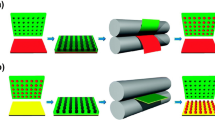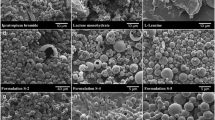Abstract
With the growing interest in developing biologics for pulmonary delivery, systematic fast screening methods are needed for rapid development of formulations. Due to the labile nature of macromolecules, the development of stable, biologically active formulations with desired aerosol performance imposes several challenges both from a formulation and processing perspective. In this study, spray-freeze-drying was used to develop respirable protein powders. In order to systematically map the selected design space, lysozyme aqueous pre-formulations were prepared based on a constrained mixture design of experiment. The physicochemical properties of the resulting powders were characterized and the effects of formulation factors on aerosol performance and protein stability were systematically screened using a logic flow chart. Our results elucidated several relevant formulation attributes (density, total solid content, protein:sugars ratio) required to achieve a stable lysozyme powder with desirable characteristics for pulmonary delivery. A similar logical fast screening strategy could be used to delineate the appropriate design space for different types of proteins and guide the development of powders with pre-determined aerodynamic properties.







Similar content being viewed by others
References
Morales JO, Fathe KR, Brunaugh A, Ferrati S, Li S, Montenegro-Nicolini M, et al. Challenges and future prospects for the delivery of biologics: oral mucosal, pulmonary, and transdermal routes. AAPS J. 2017:1–17.
Fathe K, Ferrati S, Moraga-Espinoza D, Yazdi A, DC Smyth H. Inhaled biologics: from preclinical to product approval. Curr Pharm Des. 2016;22(17):2501–21.
Garcia-Contreras L, Smyth HD. Liquid-spray or dry-powder systems for inhaled delivery of peptide and proteins? Ame J Drug Deliv. 2005;3(1):29–45.
Zhou QT, Tang P, Leung SSY, Chan JGY, Chan H-K. Emerging inhalation aerosol devices and strategies: where are we headed? Adv Drug Deliv Rev. 2014;75:3–17.
Shoyele SA, Cawthorne S. Particle engineering techniques for inhaled biopharmaceuticals. Adv Drug Deliv Rev. 2006;58(9):1009–29.
Adler M, Lee G. Stability and surface activity of lactate dehydrogenase in spray-dried trehalose. J Pharm Sci. 1999;88(2):199–208.
Costantino HR, Firouzabadian L, Hogeland K, Wu C, Beganski C, Carrasquillo KG, et al. Protein spray-freeze drying. Effect of atomization conditions on particle size and stability. Pharm Res. 2000;17(11):1374–82.
Maa Y-F, Nguyen P-A, Sweeney T, Shire SJ, Hsu CC. Protein inhalation powders: spray drying vs spray freeze drying. Pharm Res. 1999;16(2):249–54.
Costantino HR, Firouzabadian L, Wu C, Carrasquillo KG, Griebenow K, Zale SE, et al. Protein spray freeze drying. 2. Effect of formulation variables on particle size and stability. J Pharm Sci. 2002;91(2):388–95.
Webb SD, Golledge SL, Cleland JL, Carpenter JF, Randolph TW. Surface adsorption of recombinant human interferon-γ in lyophilized and spray-lyophilized formulations. J Pharm Sci. 2002;91(6):1474–87.
Passot S, Fonseca F, Alarcon-Lorca M, Rolland D, Marin M. Physical characterisation of formulations for the development of two stable freeze-dried proteins during both dried and liquid storage. Eur J Pharm Biopharm. 2005;60(3):335–48.
Carpenter JF, Pikal MJ, Chang BS, Randolph TW. Rational design of stable lyophilized protein formulations: some practical advice. Pharm Res. 1997;14(8):969–75.
Wang W. Lyophilization and development of solid protein pharmaceuticals. Int J Pharm. 2000;203:1):1–60.
Mensink MA, Frijlink HW, van der Voort Maarschalk K, Hinrichs WL. How sugars protect proteins in the solid state and during drying (review): mechanisms of stabilization in relation to stress conditions. Eur J Pharm Biopharm. 2017;114:288–95.
Zbacnik TJ, Holcomb RE, Katayama DS, Murphy BM, Payne RW, Coccaro RC, et al. Role of buffers in protein formulations. J Pharm Sci. 2017;106(3):713–33.
Carpenter JF, Chang BS, Garzon-Rodriguez W, Randolph TW. Rational design of stable lyophilized protein formulations: theory and practice. Rational design of stable protein formulations 2002:109–33.
Carrasquillo KG, Stanley AM, Aponte-Carro JC, De Jésus P, Costantino HR, Bosques CJ, et al. Non-aqueous encapsulation of excipient-stabilized spray-freeze dried BSA into poly (lactide-co-glycolide) microspheres results in release of native protein. J Control Release. 2001;76(3):199–208.
Yu Z, Johnston KP, Williams RO. Spray freezing into liquid versus spray-freeze drying: influence of atomization on protein aggregation and biological activity. Eur J Pharm Sci. 2006;27(1):9–18.
Nguyen XC, Herberger JD, Burke PA. Protein powders for encapsulation: a comparison of spray-freeze drying and spray drying of darbepoetin alfa. Pharm Res. 2004;21(3):507–14.
Sonner C, Maa YF, Lee G. Spray-freeze-drying for protein powder preparation: particle characterization and a case study with trypsinogen stability. J Pharm Sci. 2002;91(10):2122–39.
Johnson OL, Jaworowicz W, Cleland JL, Bailey L, Charnis M, Duenas E, et al. The stabilization and encapsulation of human growth hormone into biodegradable microspheres. Pharm Res. 1997;14(6):730–5.
Bi R, Shao W, Wang Q, Zhang N. Spray-freeze-dried dry powder inhalation of insulin-loaded liposomes for enhanced pulmonary delivery. J Drug Target. 2008;16(9):639–48.
Murugappan S, Patil HP, Kanojia G, ter Veer W, Meijerhof T, Frijlink HW, et al. Physical and immunogenic stability of spray freeze-dried influenza vaccine powder for pulmonary delivery: comparison of inulin, dextran, or a mixture of dextran and trehalose as protectants. Eur J Pharm Biopharm. 2013;85(3):716–25.
Amorij J-P, Saluja V, Petersen AH, Hinrichs WL, Huckriede A, Frijlink HW. Pulmonary delivery of an inulin-stabilized influenza subunit vaccine prepared by spray-freeze drying induces systemic, mucosal humoral as well as cell-mediated immune responses in BALB/c mice. Vaccine. 2007;25(52):8707–17.
Zijlstra GS, Hinrichs WL, de Boer AH, Frijlink HW. The role of particle engineering in relation to formulation and de-agglomeration principle in the development of a dry powder formulation for inhalation of cetrorelix. Eur J Pharm Sci. 2004;23(2):139–49.
Shire SJ. 4—formulation of proteins and monoclonal antibodies (mAbs). Monoclonal Antibodies: Woodhead Publishing; 2015. p. 93–120.
Dailymed. Available from: https://dailymed.nlm.nih.gov/dailymed/.
Bulk denisty and tap density. The United States Pharmacopeial Convention. 2011;General chapter <616>.
Physical tests and determinations: inhalation and nasal drug products: aerosols, sprays, and powders—performance quality tests. United States Pharrmacopeia and National Formulary (USP 39-NF 34). Rockville MD: United States Pharmacopeial Convention; 2016. p. 423–49.
Enzymatic assay of lysozyme (Sigma-Aldrich). Available from: http://www.sigmaaldrich.com/technical-documents/protocols/biology/enzymatic-assay-of-lysozyme.html.
Mohammad MA, Grimsey IM, Forbes RT. Mapping the solid-state properties of crystalline lysozyme during pharmaceutical unit-operations. J Pharm Biomed Anal. 2015;114:176–83.
Yu Z, Garcia AS, Johnston KP, Williams RO. Spray freezing into liquid nitrogen for highly stable protein nanostructured microparticles. Eur J Pharm Biopharm. 2004;58(3):529–37.
Patton JS, Byron PR. Inhaling medicines: delivering drugs to the body through the lungs. Nat Rev Drug Discov. 2007;6(1):67–74.
Byron PR. Prediction of drug residence times in regions of the human respiratory tract following aerosol inhalation. J Pharm Sci. 1986;75(5):433–8.
Miller DP, Tan T, Tarara TE, Nakamura J, Malcolmson RJ, Weers JG. Physical characterization of tobramycin inhalation powder: I. Rational design of a stable engineered-particle formulation for delivery to the lungs. Mol Pharm. 2015;12(8):2582–93.
Ji S, Thulstrup PW, Mu H, Hansen SH, van de Weert M, Rantanen J, et al. Investigation of factors affecting the stability of lysozyme spray dried from ethanol-water solutions. Int J Pharm. 2017;534(1–2):263–71.
Lee T, Chang GD. Sucrose conformational polymorphism: a jigsaw puzzle with multiple routes to a unique solution. Crystal Growth and Design. 2009;9(8):3551–61.
Ferrati S, Wu T, Fuentes O, Brunaugh AD, Kanapuram SR, Smyth HDC. A systematic analysis of the effect of formulation parameters on the aerosol performance and stability of aerosol performance and stability of spray freeze dried protein powders. Respir Drug Deliv (RDD) Conf Proc. 2018;
Acknowledgements
The authors are thankful to the members of Smyth lab (in particular to Dr. Matthew Herpin and Daniel Moraga), to Dr. Abbe Haser, and to the team at Amgen (in particular Nitin Anghan and Michael Schneider) for valuable feedbacks.
Funding
This work was supported by Amgen Inc.
Author information
Authors and Affiliations
Corresponding author
Ethics declarations
The terms of this arrangement have been reviewed and approved by the University of Texas at Austin in accordance with its policy on objectivity in research.
Conflict of Interest
The author (HDCS) of this paper consults for and has equity ownership in Respira Therapeutics and Nob Hill Therapeutics on inhaled product development. The other authors declare that they have no conflict of interest.
Additional information
Communicated By: Ajaz S. Hussain, Kenneth Morris, and Vadim J. Gurvich
Some of the findings of this study have been accepted as an abstract at the Respiratory Drug Delivery (RDD) annual conference, Tucson, NM, and will be partially published as an abstract as part of conference proceedings [38].
Electronic Supplementary Material
ESM 1
(DOCX 1428 kb)
Rights and permissions
About this article
Cite this article
Ferrati, S., Wu, T., Fuentes, O. et al. Influence of Formulation Factors on the Aerosol Performance and Stability of Lysozyme Powders: a Systematic Approach. AAPS PharmSciTech 19, 2755–2766 (2018). https://doi.org/10.1208/s12249-018-0980-9
Received:
Accepted:
Published:
Issue Date:
DOI: https://doi.org/10.1208/s12249-018-0980-9




